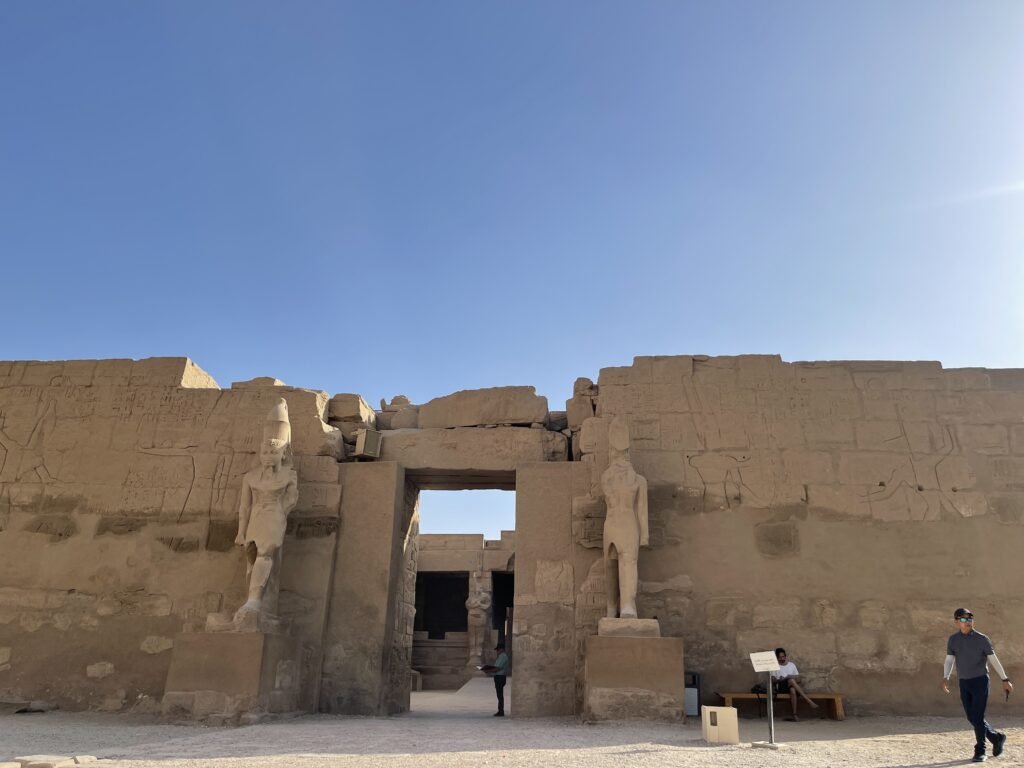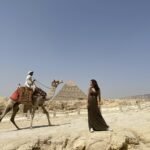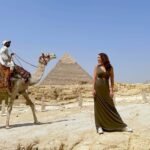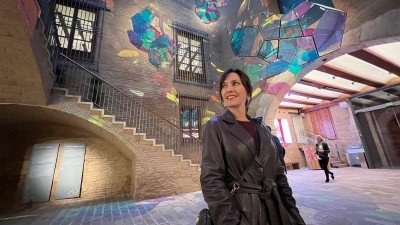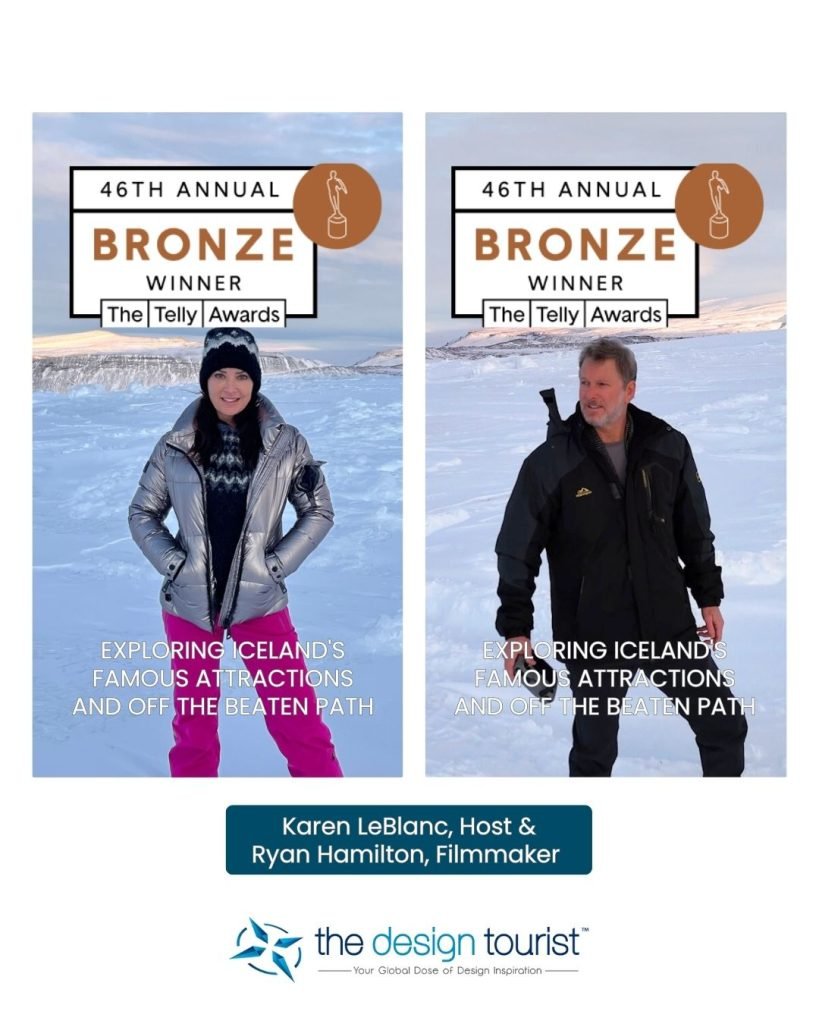I traveled to Egypt to explore the country’s iconic archeological sites on a four-day Egypt Nile River Cruise filled with fascinating stories of gods, glories, conquests, and civilizations that shaped modern-day Egypt and produced some of the world’s greatest works of art and architecture.
The Greeks, Romans, and Arabs all left their mark, beliefs, and ways of being. Egypt was home to some of humanity’s earliest artists and architects and one of the first populations to chronicle their lives in a pictorial language known as hieroglyphics.
The Ideal Way to Experience Egypt’s Archeological Treasures
The Egypt Nile River Cruise is the ideal way to experience its archeological treasures. I booked a four-night cruise departing from Aswan on the Blue Shadow as part of my ten-day exploration of Egypt with Cairo Transport & Touring. My local, English-speaking guide, Amir, is an Egyptologist, and he accompanied us to all archeological sites, sharing expert insight and fascinating stories about each site’s history, legend, and lore.
Aswan is Egypt’s southernmost city, located about 600 miles outside Cairo. We traveled by bus throughout Aswan, accompanied by a security guard provided by the tour company. Our first stop was the Philae Temple Complex, built by the Greeks to honor the Egyptian Goddess of love, Isis.
Philae Temple Complex
The Greeks built the Philae complex during the reign of the Ptolemy family, the last dynasty of ancient Egypt, known as Egypt’s Greco-Roman Period. The Ptolemies ruled for 275 years, from 305 to 30 BC. Philae Temple dates back to 285 BC as a tribute to ISIS, the goddess of love and mother of the Falcon God Horus was the ruler of the skies.
ISIS Temple holds the last known hieroglyphic writing dating to 394 A.D., the Graffito of Esmet-Akhom carved on a temple wall. Hieroglhpyics remained a language for 2500 years until it was lost to history until the discovery of the Rosetta Stone in 1799, which helped decode hieroglyphics.
The temple of Isis was one of the last ancient Egyptian temples to remain active after the arrival of Christianity in Egypt. Christians closed it in 550 AD and used the Temple of ISIS as a church after defacing some of the stone carvings to remove pagan imagery.
Whirling Dervishes Performance (on the cruise)
That evening, our cruise departs on the Blue Shadow boat for a four-night cruise down the Nile. Along the way, I enjoyed a dizzying performance of Whirling Dervishes, a Turkish dance on the UNESCO list of Intangible Cultural Heritage.
Whirling Dervishes are spinning dancers wearing ornate, glowing skirts twirling in a mesmerizing spectacle.
The Whirling Dervish originated as a religious dance by the Mevleviye in 1273. Today, secularized dancers perform for public entertainment.
Abu Simbel
The following day, I took a 4-hour bus ride to Abu Simbel to witness a fascinating feat of ancient engineering. King Ramses II built Abu Simbel Temple with two temples, one for King Ramses and one for his Queen Nefertiti. King Ramses II is one of Egypt’s longest-ruling kings, reigning for more than 60 years.
What’s fascinating about this site is that it was relocated stone by stone from its original location. Abu Simbel and Philae Temple are UNESCO World Heritage sites and part of an extensive relocation project by the Egyptian government working with UNESCO to save the monuments from flooding resulting from the construction of the High Dam in Aswan. During the three-year project, workers cut the two temples into approximately 1042 massive blocks and reassembled them to look like they were carved into the cliffs. Abu Simbel officially reopened on Sept 22, 1968.
The Egyptians built Abu Simbel as a time-keeping temple along the sun’s axis. Twice a year, on February 22nd and October 22nd, the sun’s rays enter the temple, cross the main hall, and illuminate the innermost statues.
Four massive seated statues of King Ramses dominate its façade, one of which collapsed because of an ancient earthquake.
Inside, you can see well-preserved, colorful paintings and detailed stone carvings.
Kom Ombo
Typically, the first stop on a Nile cruise departing from Aswan is Kom Ombo, about 30 miles north of Aswan. Kom Ombo, in Egyptian, translates to “heap of gold.” The Greeks built it to honor two Egyptian Gods along a stretch of the Nile infested with crocodiles.
The double temple serves two gods— Sobek, the crocodile god, and Horus, the falcon-headed god. Each side of Kom Ombo has its entry and chapel. Our guide Amir explains the Egyptian mythology tied to Kom Ombo.
“There were a lot of crocodiles in this area, and people were afraid to go to the river because of the crocodiles. They worship the crocodile as God Sobik to avoid harm and danger. Go Sobik was an evil god, so the people also wanted to worship a nice god, THe Falcon God Horace.
According to mythology, Sobik refused to be worshiped together with God Horus, so the people left, leaving no one to cultivate the fields. God Sobek used his magic to wake the dead people to cultivate the land.
Those zombies didn’t know what they were doing. Instead of throwing seeds, they threw sand, and all land became desert. God Sobek called back God Horus, and they divided the temple into two sides.
The right side is dedicated to Sobik, the main God, and the left is to Horaus. Notice there are two gates, each with the symbol of protection, the sun, two cobras, and two wings over each gate,” Amir says.
That night we set sail for Edfu and Luxor to visit more ancient archeological sites. It’s Egyptian night on the cruise, so I put on a traditional dress and head to dinner, followed by the spectacle of Bellydancers dancers.
Edfu Temple
At sunrise, a horse carriage picked me up from the cruise dock winding through the streets of Edfu to the Horus Temple.
The Greeks built the Edfu temple in 237 BC to honor the God Horus, the falcon god. It was lost to history, buried under sand until 1860, when a French archaeologist uncovered and restored parts of the temple.

A courtyard surrounded on three sides by thirty-two columns leads to the Great Hall, supported by giant pillars adorned with ornate reliefs.
The hall’s walls and ceilings display detailed depictions of Horus, astronomical signs, and hieroglyphics.
His temple was an important place of worship until 391 AD when the Roman emperor issued an edict banning paganism throughout the Roman Empire.
Our next stop is Luxor which has one-third of the world’s monuments.
Karnak Temple
Karnak Temple spans 247 acres and holds Egypt’s largest collection of temple ruins, built and modified over thousands of years by pharaohs, Muslims, and Christians who all worshipped there at different times.
Karnak Temple resides on the east bank of the Nile outside the walls of Thebes, the royal capital of Egypt during the New Kingdom (1539-1075 B.C.), now modern-day Luxor.
Karnak, a UNESCO World Heritage Site, chronicles ancient Egyptian history and architecture for over 2000 years from the Middle Kingdom 2034-1650 BC to the Romand Period 30 BC-306 AD. It served as the primary worship center for Amum-ra, the god of sun and air. His temple is the largest in the complex.
Luxor Temple
Luxor Temple resides near Karnak Temple, located in the city center of Luxor. King Ramses the second built Luxor, and as a homage to himself, he erected two towering statues stand at the temple entrance.
Two 82-foot tall obelisks originally stood at the entrance until the 19th century when Egypt gifted France one of the obelisks, which now stands in Place de La Concorde in France along the Champs Elysee.
Today remains of this vast complex include the colossal Great Colonnade Hall, almost 61 meters long, with 28 twenty-one-foot-high columns, its decoration primarily undertaken by Tutankhamun around 1330 B.C. Many of the temple’s sidewalls were torn down after the time of the pharaohs and recycled for building materials. At night, Luxor lights up all its stone carvings and statues.
The Luxor temple connects to the Karnak temple through the famous avenue of Sphinxes, lined with more than 1300 stone sphinxes.
Ancient Egyptian Kings built The Sphinx Avenue over many years, between the 18th Dynasty and 30th Dynasty, as a processional way for sacred ceremonies and festivals. The Egyptian government restored the Avenue of Sphinxes in November 2021.
Valley of the Kings
Next, we head to the Nile’s west bank near modern-day Luxor to explore the Valley of the Kings, the burial site for Egypt’s New Kingdown pharaohs.
Valley of the Kings is the site of the famous archaeology discovery of King Tutankhamun’s tomb. In 1922, archeologist Howard Carter discovered King Tut’s tomb buried under another tomb. King Tutankhamun was the boy king who ruled starting in 1332 BC for a decade before dying young.
The excavation of King Tut’s tomb unearthed more than 5000 treasures, including a solid gold coffin, a bejeweled chest plate, and a golden death mask.
The Egyptian kings buried here ruled from the 18th to 22nd dynasties. Their secret underground tombs were carved into the mountains to protect royal burial sites. Robbers looted most graves before the end of the 20th dynasty, stealing the treasures and items needed in the afterlife.
What strikes me as a tour these tombs is how the afterlife created an industry and economic engine in ancient Egypt.
Tomb preparation began while the person was alive, way before death, employing artists, architects, craftspeople, laborers, and stonemasons.
Together, they worked to create everything needed in the tomb for the afterlife, including jewelry, art, artifacts, and furniture— everything from the death mask to the amulets hidden in the strips of linen wrapping the mummified body.
Temple of Queen Hatshepsut
We end our tour of archeological sites with a visit to the temple of Queen Hatshepsut, ruler of the 18th dynasty from 1479 to 1458 B.C., at Deir el-Bahri on the west bank of Luxor. This female pharaoh ruled Egypt for 22 years.
According to legend and lore, Queen Hatshepsut dressed like a man and claimed she was of divine birth. After her husband died, she stole the throne from her stepson.
The stepson was so upset with her that he took the throne and subsequently destroyed and defaced her monuments. Queen Hatshepsut wanted her temple to look different from other Egyptian temples, so it had a unique triple terrace facade.
Hot Air Ballon Ride
I wanted to experience Egypt from the ground up, so I decided to take a hot air balloon ride. The following day brings another very early wake-up call to head out for a hot air balloon ride at sunrise. This turned out to be an adrenaline-pumping adventure.
In the early morning darkness, I watch the glowing balloons expand as flames flash and hiss, pumping hot air to inflate them.
My heart races as the breathtaking scene unfolds. I’m a little nervous. I feel vulnerable. This is my first hot air balloon ride. But once we lift off and float above the ground and into the clouds, my mind calms, and peace washes over me.
The sky is peppered with colorful balloons gliding over the landscape of farms and the Nile river valley.
I watch the sunrise bathe the landscape in daylight.
It’s time to turn back and land when I feel the balloon swaying with the wind. The pilot struggles to land it as the wind carries our balloon off course. Suddenly, we land with a thud, and our basket tips over, toppling the passengers.
I climb into ashen cropland covered in soot as nearby farmers run to our rescue. If you are an adventure seeker, a hot air balloon ride is a wild ride.
My takeaway:
I traveled to Egypt during Ramadan, a month-long religious observance for Islam, the official religion of Egypt. During Ramadan, practicing Muslims fast from sun up to sundown and pray five times a day.
As a Western traveler, I had some trepidation about heading to the Middle East during Ramadan. I was concerned that attractions, restaurants, and stores would be closed or keep irregular hours. Most tourist attractions maintained regular operating hours, and those that didn’t, typically closed an hour early to accommodate Egyptians heading home to break their fast with Iftar (known as breakfast).
I discovered the timing of my trip to Egypt offered a richer experience of Egyptian culture with celebrations, culinary creations, decorations, and design finds that surface once a year.
Watch more about my adventures along the Nile in this episode of The Design Tourist:
What to know if you go:
I recommend at least ten days to explore Egypt’s major highlights, including significant archeological sites and Cairo.
The official language is Arabic, and most Egyptians speak a regional dialect. Outside of major tourist and urban areas, English isn’t widely spoken. Be prepared to navigate a language barrier if you don’t know Arabic.
You need a tourist visa to travel to Egypt. You can apply online at the Egypt e-Visa Portal at www.visit2Egypt.gov.eg. A tourist visa is valid for three months, although my travel plans called for a 10-day stay in the country.
The Egyptian pound (EGP) is the main currency. I recommend taking cash as US dollars in addition to credit and debit cards.
Egypt has a cash-based tourism industry. Many places don’t take credit cards. Many establishments, including cruise boats and hotels, want cash because they don’t want to pay credit card fees.
Tipping is expected everywhere and, in my opinion, excessive, not earned. The culture and service staff consider it an entitlement.
If you want to know the full list of recommended places in Egypt, visit my listing on Listium.com.

































